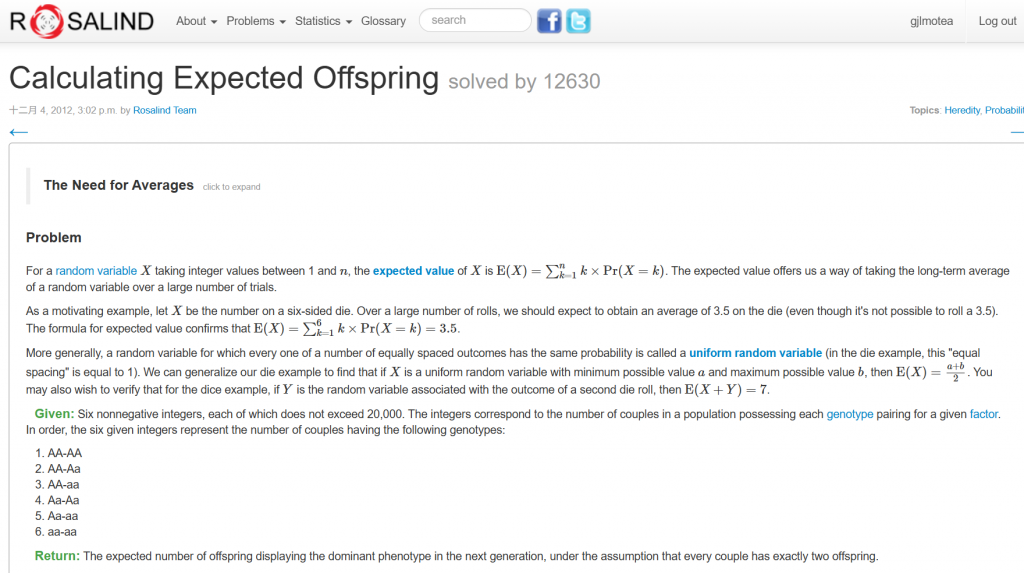今天這題很快!
一下就下課囉
題目連結:https://rosalind.info/problems/iev/

輸入:
1 0 0 1 0 1
輸出:
3.5
計算子代的顯性性狀數量!
所以拿到資料第一步驟,將一連串的字串切割,轉成數字以陣列存放
再運用龐尼特方格,直接將每一種配對 顯性機率的期望值計算出來,作為權重
基因型配對的權重:
AA-AA:1(怎麼生都是顯性)
AA-Aa:1(怎麼生都是顯性)
AA-aa:1(怎麼生都是顯性)
Aa-Aa:0.75
Aa-aa:0.5
aa-aa:0(怎麼生都是隱性)
最後將數字乘上權重,再乘上子代數量即可
程式碼:
data = "1 0 0 1 0 1"
counts = [int(x) for x in data.split(" ") if x.isdigit()]
weight = [1, 1, 1, 3 / 4, 1 / 2, 0]
offspring = 2
result = [d * w for d, w in zip(counts, weight)]
print(sum(result)*offspring)
寫成function
可以再加做一個陣列長度的檢查
def expected_offspring(raw_data: str, offspring: int = 2) -> float:
weight = [1, 1, 1, 0.75, 0.5, 0]
counts = [int(x) for x in raw_data.split() if x.isdigit()]
if len(counts) != len(weight):
raise ValueError(f"資料長度不符: data={len(counts)}, weight={len(weight)}")
if any(d < 0 for d in counts):
raise ValueError("輸入的配對數不可為負數")
return offspring * sum(d * w for d, w in zip(counts, weight))
print(expected_offspring("1 0 0 1 0 1"))
透過簡單題目,矩陣運算來加減練習numpy的使用方法
初始化陣列時,可以不指定dtype,因為numPy會自動推斷
如果若有混合型別(ex: int + float),numpy會自動轉成「能容納全部資料的最高型別」
型別升階邏輯 type promotion hierarchy:
bool → integer → floating → complex → string → object
(complex 是 複數 = 實部+虛部)
但是建議在開發時,
如果能夠確定型別就自己寫、明確指定dtype,可以避免未來推斷錯誤
import numpy as np
raw_data = "1 0 0 1 0 1"
# counts = np.fromstring(raw_data, sep=' ', dtype=int) # 指定dtype寫法
counts = np.fromstring(raw_data, sep=' ')
weights = np.array([1, 1, 1, 0.75, 0.5, 0])
# weights = np.array([1, 1, 1, 0.75, 0.5, 0], dtype=float) # 指定dtype寫法
offspring = 2
expected = offspring * counts.dot(weights) # = 2 * Σ(counts_i * weights_i)
print(expected)
改寫成function
import numpy as np
def expected_offspring(raw_data: str, offspring: int = 2) -> float:
counts = np.fromstring(raw_data, sep=' ', dtype=int)
weights = np.array([1, 1, 1, 0.75, 0.5, 0], dtype=float)
if counts.size != weights.size:
raise ValueError(f"資料長度不符: counts={counts.size}, weights={weights.size}")
if (counts < 0).any():
raise ValueError("輸入的配對數不可為負數")
return float(offspring * counts.dot(weights))
print(expected_offspring("1 0 0 1 0 1"))
(counts < 0).any()
與
any(x < 0 for x in counts)
雖然都是做一樣的事情(迭代迴圈)
但一個是給py迴圈(上者)用Python在一個一個元素上比對,逐項
一個是給更快的C做迴圈(下者)NumPy在C底層一次性批次運算,向量化
早期Python沒有內建任何矩陣或向量功能。
資料科學家、軟體工程師如果要做矩陣運算
只能用以下寫法
for i in range(n):
for j in range(n):
c[i][j] = a[i][j] + b[i][j]
Python每個元素都要型別檢查、函式呼叫,開銷極大
後來有人目標想讓Python有MATLAB那樣的矩陣
在 C 語言中寫了一套底層實作,讓Python只負責呼叫介面。
NumPy在C層一次批次處理整塊連續記憶體,開銷極小
兩者速率大概相差20-200倍,取決於資料量
